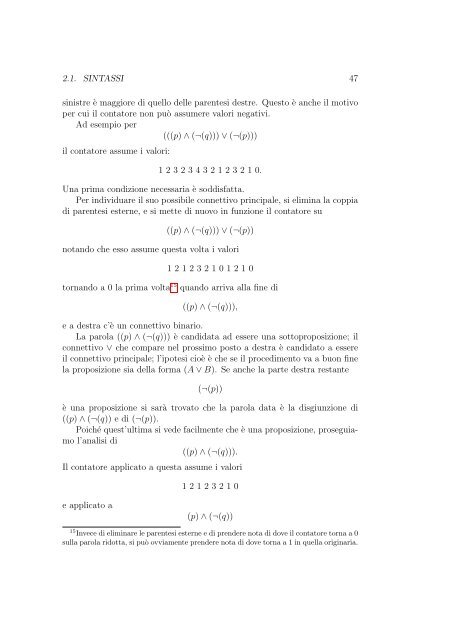Logica Matematica Corso di Laurea in Informatica ... - Mbox.dmi.unict.it
Logica Matematica Corso di Laurea in Informatica ... - Mbox.dmi.unict.it
Logica Matematica Corso di Laurea in Informatica ... - Mbox.dmi.unict.it
You also want an ePaper? Increase the reach of your titles
YUMPU automatically turns print PDFs into web optimized ePapers that Google loves.
2.1. SINTASSI 47<br />
s<strong>in</strong>istre è maggiore <strong>di</strong> quello delle parentesi destre. Questo è anche il motivo<br />
per cui il contatore non può assumere valori negativi.<br />
Ad esempio per<br />
(((p) ∧ (¬(q))) ∨ (¬(p)))<br />
il contatore assume i valori:<br />
1 2 3 2 3 4 3 2 1 2 3 2 1 0.<br />
Una prima con<strong>di</strong>zione necessaria è sod<strong>di</strong>sfatta.<br />
Per <strong>in</strong><strong>di</strong>viduare il suo possibile connettivo pr<strong>in</strong>cipale, si elim<strong>in</strong>a la coppia<br />
<strong>di</strong> parentesi esterne, e si mette <strong>di</strong> nuovo <strong>in</strong> funzione il contatore su<br />
((p) ∧ (¬(q))) ∨ (¬(p))<br />
notando che esso assume questa volta i valori<br />
1 2 1 2 3 2 1 0 1 2 1 0<br />
tornando a 0 la prima volta 15 quando arriva alla f<strong>in</strong>e <strong>di</strong><br />
((p) ∧ (¬(q))),<br />
e a destra c’è un connettivo b<strong>in</strong>ario.<br />
La parola ((p) ∧ (¬(q))) è can<strong>di</strong>data ad essere una sottoproposizione; il<br />
connettivo ∨ che compare nel prossimo posto a destra è can<strong>di</strong>dato a essere<br />
il connettivo pr<strong>in</strong>cipale; l’ipotesi cioè è che se il proce<strong>di</strong>mento va a buon f<strong>in</strong>e<br />
la proposizione sia della forma (A ∨ B). Se anche la parte destra restante<br />
(¬(p))<br />
è una proposizione si sarà trovato che la parola data è la <strong>di</strong>sgiunzione <strong>di</strong><br />
((p) ∧ (¬(q)) e <strong>di</strong> (¬(p)).<br />
Poiché quest’ultima si vede facilmente che è una proposizione, proseguiamo<br />
l’analisi <strong>di</strong><br />
((p) ∧ (¬(q))).<br />
Il contatore applicato a questa assume i valori<br />
e applicato a<br />
1 2 1 2 3 2 1 0<br />
(p) ∧ (¬(q))<br />
15 Invece <strong>di</strong> elim<strong>in</strong>are le parentesi esterne e <strong>di</strong> prendere nota <strong>di</strong> dove il contatore torna a 0<br />
sulla parola ridotta, si può ovviamente prendere nota <strong>di</strong> dove torna a 1 <strong>in</strong> quella orig<strong>in</strong>aria.




![Introduzione ai sistemi Wiki [PDF] - Mbox.dmi.unict.it](https://img.yumpu.com/16413205/1/184x260/introduzione-ai-sistemi-wiki-pdf-mboxdmiunictit.jpg?quality=85)











